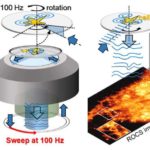Biological Discoveries: (Article), Rotating blue laser light reveals unimagined dynamics in living cells
When cities transform into a colorful world of lights as darkness falls, it’s often only possible to estimate their contours, which depending on the perspective can draw the attention to key details or trivia. In fluorescence microscopy, biological cells are marked with fluorescent dyes and excited to luminesce in specific areas by optical switches- like a city at night. However, this light is usually too faint for small, rapid objects, or even goes out after a while. This is known as ‘fluorescence bleaching.’ Now, researchers have developed a new way to make the smallest objects clearly visible without fluorescence. In this way, cellular structures or virus-sized particles can be observed 100 to 1,000 times longer, ten to 100-times faster and with almost doubled resolution than with fluorescence microscopy.
Learn about our two Decals!
 Click here to find out more about our Fall Bioinspired Design Decal and our Spring Bioinspired Design in Action Decal – ALL MAJORS are welcome.
Click here to find out more about our Fall Bioinspired Design Decal and our Spring Bioinspired Design in Action Decal – ALL MAJORS are welcome.Berkeley BioDesign Community
 Click here to learn about the BioD: Bio-Inspired Design @ Berkeley student organization or here to signup for more info.
Click here to learn about the BioD: Bio-Inspired Design @ Berkeley student organization or here to signup for more info.Search
Student Login




I imagine that the neurological circuits underlying these processes are governed by both 2d spacing maps with their brains as…
to reduce the impact of car accidents, it may be possible to study the force diverting physics of cockroaches to…
you see this type of head-bobbing stability in many avian creatures related to pigeons like chickens. the head ability to…
not like they taught horses how to run! this is an example of convergent evolution where both sea creatures and…
The brain functions in a similar way with neuronal connections. our brains are able to utilize the multiplicity of connections…